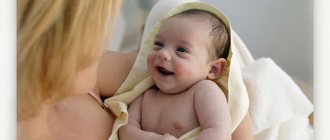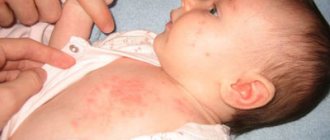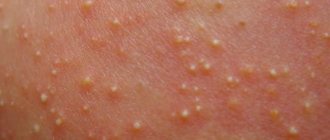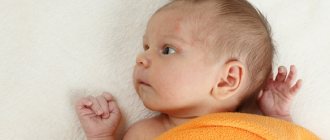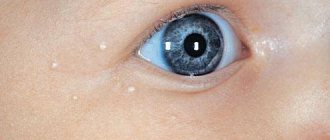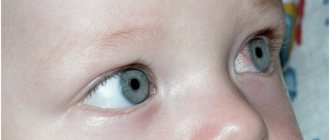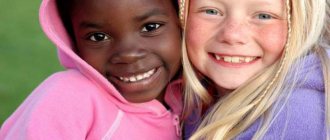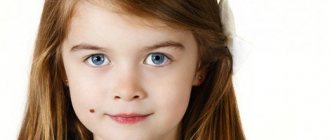White pimples in newborns can appear on the skin immediately after birth, even while in the maternity hospital. In many cases, such rashes develop in a child 2-3 weeks after birth. They are observed in 50% of infants.
Acne
Acne - the reason for their appearance lies in the hormonal background of the child. Its restructuring is not complete at the time of birth, and the mother’s hormones are still present in the body. This occurs when a woman synthesizes excessive amounts of estradiol during pregnancy. The possibility of it entering the child’s body is high. In such cases, the newborn, in addition to the appearance of white pimples on the body, may experience puberty symptoms. If necessary, drug treatment is carried out to level out the increased hormonal levels. The location of acne is the face and neck. Multiple rashes have a yellowish tint. When they appear, it is necessary to keep the skin clean and dry.
Prickly heat
During the hot season, a child may develop prickly heat on the skin in the form of white or pink spots and pimples. They occur with hyperhidrosis - increased sweating. This may occur as a result of high room temperatures, or if the infant is overly wrapped or wearing too warm clothing. On constantly moist skin, white pimples appear in newborns, first in the neck area, then spreading to the face. Miliaria can be stopped if comfortable conditions are created: the temperature in the room should not exceed 18-220 C. To prevent rashes from recurring in the future, the child’s clothes should be made of natural materials.
Milia
Milia (milia) - “millet grains”, are located mainly on the face. Their appearance is associated with the functioning of the sebaceous glands, which begins immediately after the birth of the child. During this period, the glandular ducts still go through a stage of formation. Therefore, the fat produced by the glands themselves does not come out, but accumulates in their cavity, forming white pimples. Thus, the immaturity of the sebaceous glands is manifested. Milia develop as a result of blockage of the excretory ducts of the glands, look like small pearls and appear as single elements. The appearance of milia does not pose a danger to the child’s health. They do not cause discomfort, pain, itching, fever or deterioration of health. White pimples in newborns are not skin diseases and are not manifestations of pathology. They are completely harmless and do not require special treatment. They are a natural adaptive reaction.
It is necessary to wash and wipe the baby dry in the morning and evening, and without fail - after each feeding. They disappear after about 1-1.5 months on their own, when the ducts of the sebaceous glands are cleared. There are no scars or stains left in their place.
What to do if small red pimples appear on a baby
Red pimples on the body sooner or later appear in every infant. They represent a manifestation of either a disease or a reaction to the influence of the surrounding world. These red pimples can appear on any part of a child’s body for various reasons.
On the head
In the first days of life, both red and white rashes may appear in the scalp area of a baby, which are a consequence of excess hormones. Such hormonal irritations may appear on other parts of his body (even on the gums) until normal hormonal levels are established in the body.
Hormonal rashes should not be treated, since the baby’s body can cope with such a problem on its own. However, you need to make sure that the baby does not pick or scratch the pimples.
The formula for losing weight is simple - burn more calories than you take into your body. The mistake of all those who lose weight! Girls, just lose weight, here’s the recipe: before breakfast...
Read more…
Also in the head area, namely from the scalp, chickenpox can begin, which quickly spreads throughout the baby’s entire body. Such rashes are watery and accompanied by itching. To treat chickenpox acne, they need to be treated with brilliant green.
On the neck
Such small pimples usually develop due to miliaria, which irritates the delicate skin of a newborn when he is overheated. In appearance, these pimples are pink or red in color with small water heads.
E. Malysheva: Lately I have been receiving a lot of letters from my regular viewers about breast problems: MASTITIS, LACTOSTASIS, FIBROADENOME. To completely get rid of these problems, I advise you to familiarize yourself with my new technique based on natural ingredients...
Read the review...
On the butt
Irritation on the bottom may appear due to a reaction to diapers or washing powder that are not suitable for children or specifically for your baby. Acne can also appear on the arms, legs, abdomen, and papilla.
On the cheeks, nose, forehead, back and chest
Such pimples appear in a newborn in the first months of life. They are not the result of an allergic reaction, illness or overheating. This occurs due to hormonal instability, which improves on its own within two weeks.
In the chin area, ears and butt
Many parents, noticing pimples in these places, think that their child has an allergy. You should not immediately panic: diathesis is accompanied by symptoms such as redness, burning and itching. If the baby tries to scratch the rash, you should consult a doctor and review the mother's diet, eliminating the allergen.
In the mouth
Rashes in the mouth most often appear precisely because of chickenpox on the 2nd day of the disease. Blisters usually form on the gums. This period of the disease is accompanied by loss of appetite in the baby, fever and painful sensations when eating, as a rash may break out on the palate or gum. With severe damage from third-party intervention, blood stains may form on the gums.
In the ear area
Measles can begin with a rash near the ears, which then spreads throughout the baby’s entire body. Measles presents with symptoms similar to a cold and produces pink pimples.
On the pussy, back and armpits
Scarlet fever manifests itself in these parts of the body, which is accompanied by symptoms such as:
- heat;
- inflammation of the mucous membranes and throat in the mouth;
- vomit;
- rough red rashes that begin to peel off after 3 days.
Rashes all over the body
- Disturbance of intestinal microflora. In addition, the color of the stool also changes, constipation or diarrhea appears, bloating occurs, and colic becomes more frequent. The blisters may be purulent. Most often located on the baby's bottom.
- Rubella. This disease is characterized by flat pimples that quickly localize throughout the body.
- Large red rashes may appear due to eczema, which either recedes or returns. Such pimples flake and cause itching, resulting in the formation of a crust on their surface.
- Scabies. Sometimes a baby develops scabies, rashes that appear on the entire surface of the body except the back. It is characterized by an itchy cluster of crusty pimples. Most blisters form on the hands.
Children develop white rashes.
If the rash is covered with a white crust, it may be the following formations.
- Comedones are narrow and shiny papules with a yellow or white tint. They do not pose any harm to the baby and pass quickly.
- Milia. Such irritations are not accompanied by inflammation. They resemble wen in appearance. Such white pimples do not need to be treated, as they go away when the baby’s sebaceous glands normalize.
How to fight
The main measure to combat rashes is hygiene, which consists of regular ventilation, bathing, and also washing the baby after changing the diaper. It is important to choose a brand of diapers that will not cause a reaction on your baby’s bottom.
To prevent prickly heat, you need to dress your baby depending on the weather conditions and use special creams for the folds on the baby’s body. At home, it is necessary to select breathable clothing for the baby.
If red pimples are located on the butt, arms or nipple and are accompanied by itching, you can make a soda-based compress. To prepare it, you need to mix 1 teaspoon of baking soda with a glass of water at room temperature.
Allergenic foods that can lead to colic, dysbacteriosis and allergies, leading to skin rashes on the baby’s body, should be excluded from the mother’s diet.
To get rid of acne on the gums and mouth, it is necessary to cure the disease that caused them. To prescribe treatment, you must consult a doctor. To prevent blisters from appearing on the gums, you must ensure that your child does not put dirty objects in his mouth.
grudnichky.ru
Localization of pimples in newborns
In some cases, milia appear in the form of single elements on the upper or lower eyelid of a child - the so-called millet. The main reasons for their appearance on the eyelids include:
• allergens;
• exposure to ultraviolet radiation;
• calcium deficiency during teething;
• as in most cases - blockage of the sebaceous gland.
No special drug treatment is required. It is necessary to find out the cause of the occurrence in order to remove it. The main treatment is hygiene.
White pimples in the mouth occur for various reasons. The most common cause is stomatitis. Occurs when using an unsterile nipple for a bottle or pacifier, or when kissing relatives.
The appearance of pimples on the palate can be a manifestation of dysbiosis. It occurs when a child is treated with antibiotics.
Milia often appear on the genitals. The reason for their appearance is the same: blockage of the sebaceous glands, with the restoration of their normal functioning everything goes away. But with such a localization, the child must be shown to a pediatrician or dermatologist: this may be the initial manifestation of a urogenital infection - mycoplasmosis.
The appearance of such white pimples in newborns on the skin of the body has the same reasons:
• excess maternal hormones;
• blockage of sebaceous ducts.
Constant hygiene measures are required:
• daily bathing and air baths;
• It is not recommended to apply creams or oils to the entire body - they make skin breathing difficult and can cause blockage of the ducts.
Small pimples broke out on baby
Rashes on the face and body of newborns are not a disaster. In fact, almost every second parent faces this problem. And sometimes a rash is a variant of the norm. In particular, small pimples in a baby can be:
- Milia, or small whiteheads (usually found on the nose and chin).
- Erythema toxicum - yellowish-white pimples with a reddish ring.
- Prickly heat.
- Red pimples and pustules, like teenagers.
- Allergic rashes (most often found on the cheeks).
- Manifestations of dermatitis.
The listed causes of acne are quite harmless; they do not pose a direct threat to the child. But sometimes a rash becomes a symptom of infectious diseases and other serious conditions.
Only an experienced pediatrician can accurately determine the causes of acne.
Treatment and prevention of rashes on a child’s skin
Since all white pimples that appear on a child’s body for any reason do not require medication or any other treatment, to avoid such rashes or not cause them to spread further, proper skin care is necessary.
It is not recommended to open them for any type of rash. You cannot treat pimples yourself with solutions containing alcohol, lotions, or ointments.
When the first symptoms appear, you should contact your pediatrician or dermatologist, who will determine the cause of the pimples and give advice on how to care for your newborn.
Red and white pimples on the body of a newborn. What is this?
After the birth of a child, many mothers are horrified to find white or red pimples on the baby’s body. The whole family is wondering – what to do? But you shouldn’t panic so quickly, because rashes do not always indicate the presence of pathology.
The rash comes in different colors, sizes and is located on different parts of the body, causing discomfort or not affecting the child’s condition in any way. All this depends on the type and mechanism of their appearance.
During pregnancy, the organisms of the mother and fetus are closely connected to each other by the circulatory system. In later stages, the placenta becomes more permeable, and the mother’s hormones penetrate through it and affect the baby’s body.
1-3 weeks after birth, the effect of these hormones ends and small white pimples appear on the baby’s body (milia). They have no signs of inflammation, are absolutely painless and disappear without a trace after 2-3 months.
Such a rash does not require treatment, because it is a physiological phenomenon. Milia are sterile, therefore, when trying to squeeze out, there is a risk of introducing and spreading an infection, that is, only. Will make the situation worse.
Allergy
When a red rash appears, which will be located on the face, arms or stomach, you should first of all think about allergies. Such rashes can itch, which will lead to irritability and tearfulness in the child. He may try to scratch it on his own. The reaction develops mainly to foods eaten by a nursing mother (oranges, chocolate, etc.) or pets (wool, daphnia).
Diathesis
This is a food intolerance to certain foods that goes away over time. It manifests itself as red spots, pimples, peeling and crusts on the baby’s face.
Dermatitis
The baby's skin is very delicate and sensitive. With prolonged exposure to moisture, steam or elevated temperatures (diapers, nappies), maceration develops, against which a painful rash appears. Especially often, we can observe such a picture in skin folds and places where clothing touches.
Dysbacteriosis
At birth, the baby's intestines are sterile. After the first sip of milk, the gastrointestinal tract is activated and colonized by the mother's microorganisms. Until a stable microflora is established in the baby, he may be tormented by dysbacteriosis, intestinal colic and small reddish rashes all over the body.
Infectious pathology
These include the following diseases:
- measles;
- rubella;
- chicken pox;
- scarlet fever;
- chicken pox.
As long as the baby consumes mother's milk, the risk of getting sick is negligible.
Types of acne on a newborn's body
Conventionally, depending on the appearance, they can be divided into 2 groups:
- Red pimples on the body of a newborn. This includes all non-purulent processes (diaper rash, infectious diseases, irritation due to dysbacteriosis and diathesis);
- White pimples on a newborn's body require much closer attention. A pustule is a formation filled with pus. The appearance of such a rash indicates the penetration of the pathogen into the body. If such a rash is widespread, then this is a reason to urgently consult a doctor.
Treatment of pimples on the body of a newborn
When rashes appear in infants, parents should be vigilant. The rash should be carefully examined and, if possible, counted (to periodically control the quantity). Be sure to measure your baby's body temperature. You can also take the following steps:
- Hygienic regime. If there is no fever, the child needs to take a bath. It is advisable to add a decoction of herbs (chamomile, calendula, sage), which are hypoallergenic antiseptics, to the water. This procedure will help disinfect, soften and soothe the skin. It is better not to use chemicals.
- Throughout the day, wipe the damaged areas with a damp towel (2-3 times) and leave in the air until dry.
- The child should be dried with a natural, soft towel. It is advisable that it is not painted in bright colors, because a reaction may develop to chemical dyes. You need to wipe gently - getting wet.
- Air baths. To do this, you need to create a comfortable temperature regime - 25-26 ° C and free access of air to the damaged areas.
- After water procedures, you need to thoroughly powder your skin.
- If you are breastfeeding, you need to urgently review your menu. Everything red, spicy, fried, fatty, eggs and chocolate should be excluded. From vegetables and fruits, you can eat what grows within your region.
- If there are animals in the house, they must be isolated. Daphnia (fish food) is also an allergen. You should remove fluff and carpets from your home and carry out wet cleaning regularly. Books must be behind glass.
- Do not use alcohol solutions to wipe the rash. Babies' skin is very delicate and sensitive - chemical burns can occur.
- For wiping, you can use Chlorophyllipt solution and infusions of various plants (chamomile and sage are popular).
- Lubricate the skin with cream or lotion. This will hydrate it and help it recover.
If there is no improvement, you urgently need to consult a qualified doctor.
Prevention of pimples on a newborn's body
To prevent the appearance of rashes, you need to pay a lot of attention to hygiene - the baby should have his own bath, towel and individual detergents.
Complementary foods should be introduced gradually and allergenic foods should be avoided. Diapers should be changed frequently - the child should not be allowed to remain in wet diapers for a long time. The temperature and humidity of the room where the baby is located should be comfortable.
2016-05-15
2prishi.ru
Child hygiene
It is important to carry out constant and regular hygiene procedures with your child.
Daily bathing of the child in a weak solution of manganese is indicated. Baths with decoctions of herbs that have antiseptic and anti-inflammatory properties are effective: chamomile, string. It should be remembered that any medicinal herbs can cause allergic reactions. In this regard, careful monitoring of the skin condition is necessary: if red spots appear, this may be a manifestation of an allergy.
Most often, white pimples appear on the face, so it is necessary to thoroughly wash your face after eating several times a day, patting the skin dry. If it is not possible to wash with running water, you need to wipe your face with a damp towel. After washing, do not wipe, but only blot the delicate skin of your face.
To avoid skin damage, scratching pimples and the occurrence of inflammatory processes on the face, the child needs nail care: nails should be trimmed in a timely manner and scratch mittens should be worn on the hands.
It is not recommended to apply baby cream or oil to skin with rashes, as they form a greasy film and prevent oxygen penetration. This can give rise to pustular formations. Medicinal ointments, especially hormonal ones, are prescribed only by a doctor.
